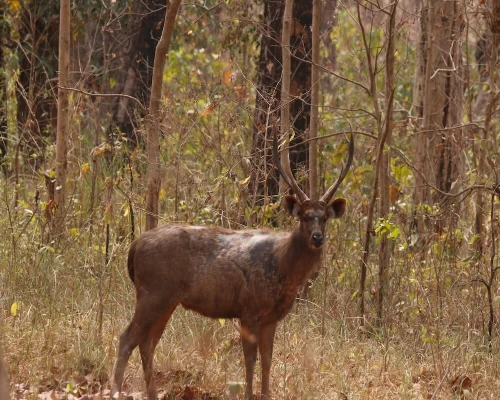Being a small nation in its area and population, Nepal has a wide variety of populations with the diversification of its culture and traditions. Nepal is blessed with greenery, forests, water resources, and the eye-catching Himalayas from a geographical point of view. Although Nepal is not much developed in terms of infrastructural buildings, it can provide a home to various species of birds and animals.
There are many dense forests in different parts of Nepal. Despite being known for its natural beauty, Nepal has also been overfilled with many animals and birds that are rare and less found in other parts of the world. The country is divided into three regions: the Terai, hilly, and mountain regions; the variety of animals and birds living in these areas is also diversified according to their favorable environment. Terai is a hot region, so animals that can adapt to the hot climate live in this area. Domestic animals like cows, buffalo, goats, and others live in the Terai region and the hilly region, but they cannot adapt to the mountain region. Animals such as yaks, donkeys, and snow bears cannot survive in hot climates. So, as per the necessity of the habitat, Nepal can be home to an uncountable number of animals and birds.
For a long time, different animals have been victimized by hunters who illegally hunt wild animals for their skin, horns, trunks, and other body parts. This crime is recognized and punishable by our law, but still, illegally, the poachers are killing the animals, which makes them rare and endangered species.
Randomly, lots of trees are cut down to increase human settlement. Deforestation is taking away the homes of many wild animals and birds. Our wild animals are being made homeless day by day, so our government has made different laws to punish those who cut down trees illegally and without permission. It has been strictly prohibited to hunt and kill animals. We have also criminalized under our law because of poaching and killing animals for their organs and transporting them to the international level.
There have been many national wildlife conservation parks to preserve and promote wildlife. Among them, Bardia National Park is also one that can provide a home to many nature.
Bardiya National Park
The lowland Terai region of Nepal is home to Bardia National Park, which spans 968 square kilometers. In Nepal's Western Terai, Bardia National Park was formed to safeguard representative ecosystems and conserve the habitat of tigers and their prey species. Initially, it was constructed as a tiny Karnali Wildlife Reserve by relocating about 1,500 Babai Valley residents. Households were relocated to allow the reserve, flora, and animals to thrive. It was then renamed Bardia Wildlife Reserve, and in 1988, it was elevated to Bardia National Park. Then, one-horned rhinoceros were moved from Chitwan National Park to Bardia National Park. A 327-square-kilometer buffer zone has been established, with the park and surrounding residents working together to administer it. The Karnali River in the west, the Churia River in the north, and the Babai River passes through Bardia National Park.
Flora and fauna in Bardia National Park
Bardia National Park has a large amount of wildness and a diverse range of species, flora, and environmental balance. Sal trees cover 70% of forests, a combination of grassland and riverine woodland. The lush woods of Bardia National Park's east side provide excellent habitats and corridors for various animal species. The endangered gharial crocodile, marsh mugger, and Gangetic dolphin live in the Karnali and Babai rivers that pass through Bardia National Park. Birds such as herons, egrets, black-necked storks, and small pratincole make their home in the riverine woodland along the beach.
The Royal Bengal Tiger, wild elephant, one-horned rhinoceros, swamp deer, blackbuck, and endangered birds such as the Bengal florican, smaller florican, and Sarus crane, can all be found in Bardia National Park. Bardia National Park is home to more than 30 animals, 230 bird species, and various snakes, reptiles, and fish. The park attracts a variety of migrating birds each year.
The Jungle Safari at Bardia National Park includes activities that transport visitors into nature and wilderness, giving them the best possibility of seeing various flora and wildlife. The Jungle Safari at Bardia National Park also allows visitors to interact with the Tharu and the local community and learn about their way of life and culture.
The Jungle Safari at Bardia National Park takes you into tiger territory and teaches you about tiger habitat, prey, and how the park tracks them. Various types of birds, reptiles, animals, fishes, crocodiles, and Gangetic dolphins may also be found in the park. In addition, you will be able to take in the scenery around the Karnali river and the golden romance of sunset on the river's bank.
Visitors may also watch the museum and Tharu traditional performances and lifestyles. The Tharu ethnic group is indigenous to the area and one of Nepal's indigenous groups. As souvenirs, the Tharu community's handicrafts are available.
From Kathmandu, fly to Nepalgunj and then drive to Bardia National Park. From the time you arrive at Bardia National Park till the time you go, the Mountain Rock Treks and Expedition have planned a full schedule of activities to explore as much of the park as possible. The mountain rock treks and expeditions ensure that visitors see every nook and cranny of Bardia National Park in the time allotted. We also offer several customization choices for the four-day/3-night Jungle Safari in Bardia National Park.








